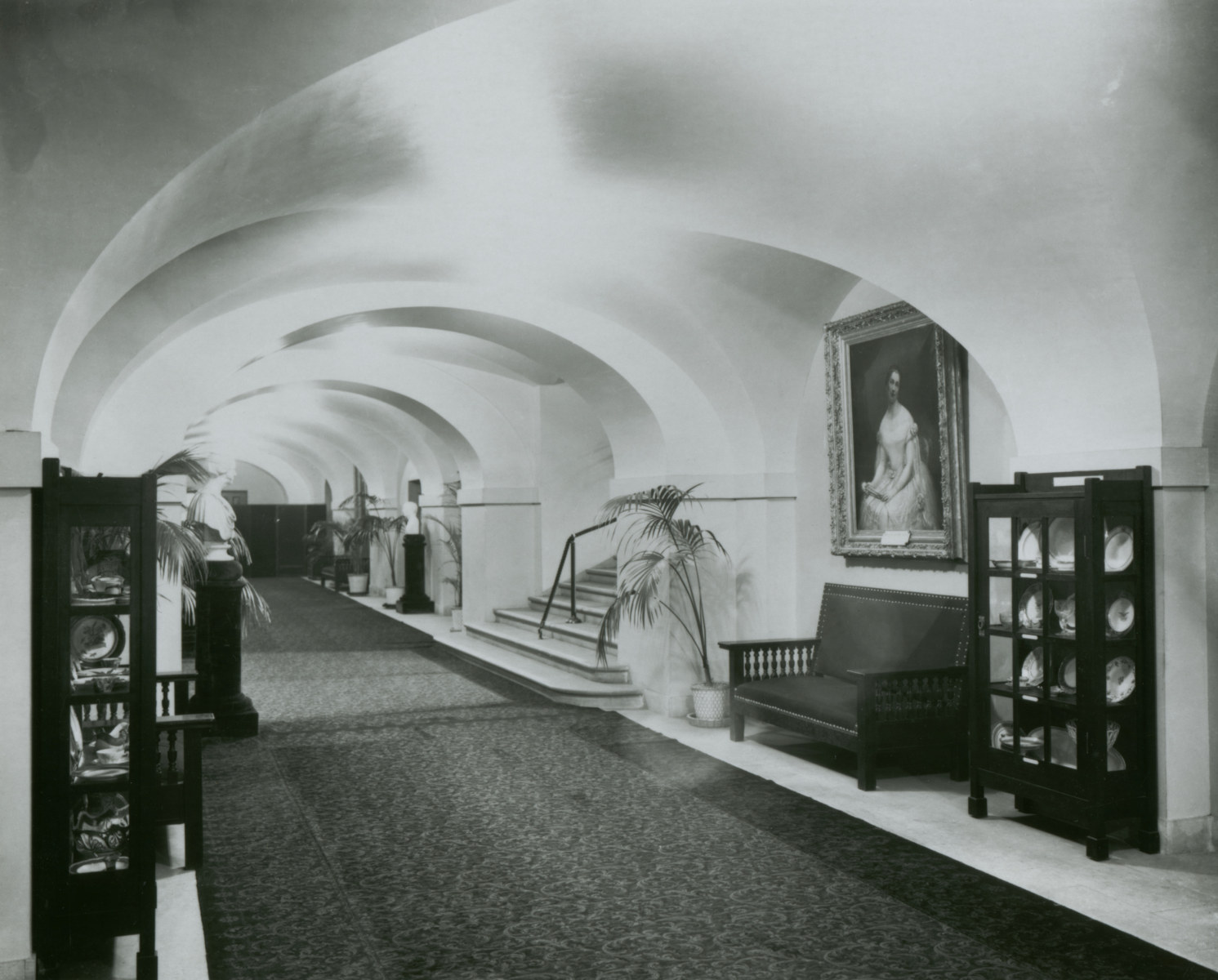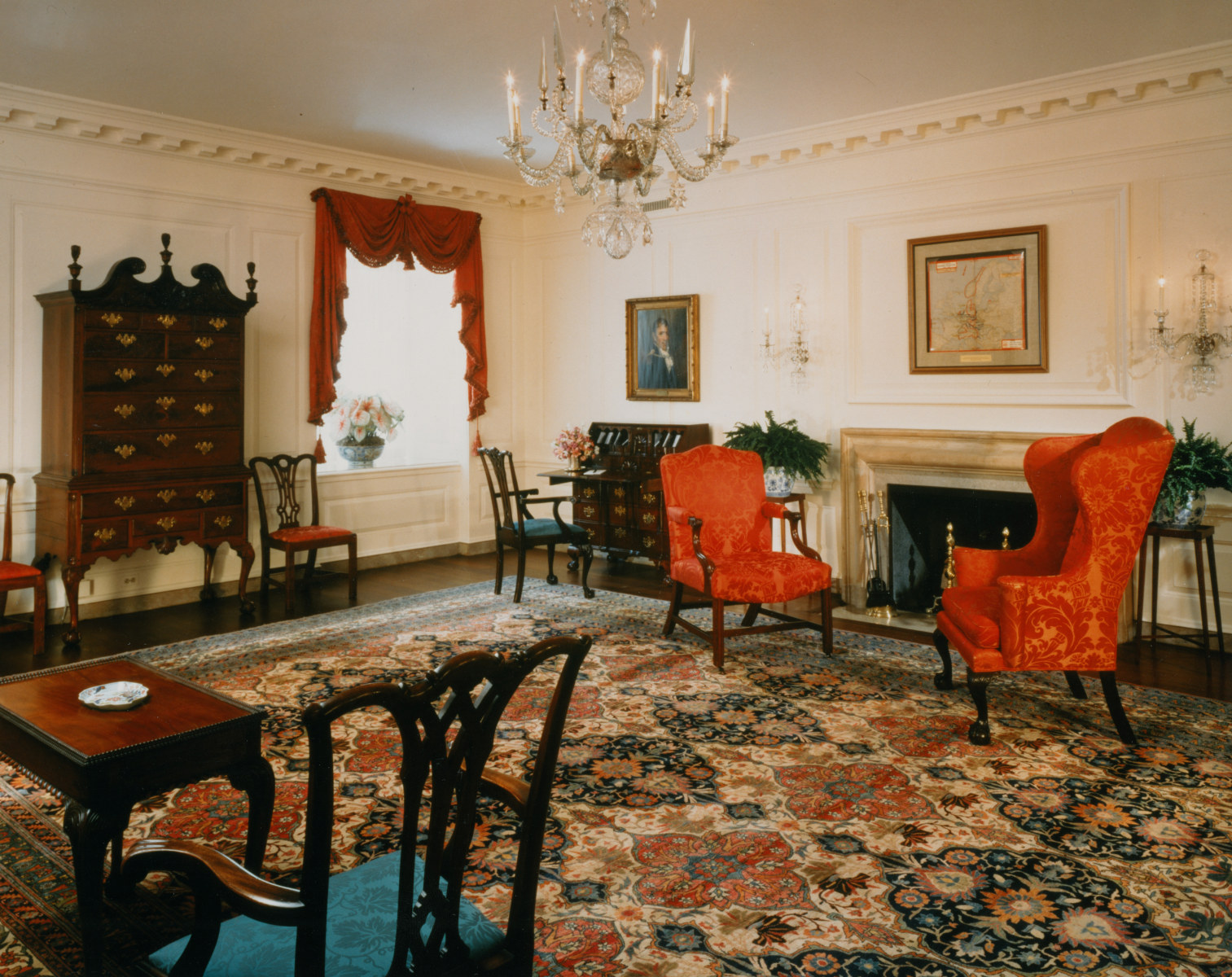Collection Presidential and First Lady Portraits
Since 1965, the White House Historical Association has been proud to fund the official portraits of our presidents and first ladies,...
Main Content
The Library, Vermeil Room, China Room, Diplomatic Reception Room, and the Map Room
The white marble walls of the Ground Floor corridor complement the vaulted ceiling arching gracefully overhead. Architect James Hoban installed the groin vaulting around 1793. Its sturdy construction withstood the fire of 1814. The vaulted ceiling seen today is a copy of the original vaulting built during the Truman Renovation between 1948 and 1952. One of the house's finest architectural elements, this ceiling was hidden from public view for more than a century. Until the mid nineteenth century, the corridor was washed in lime to prevent mildew. The space was primarily used as a workspace for free and enslaved domestic staff, but served as a storage space as well. It housed a small fire engine for James Monroe and a rowboat for John Quincy Adams. Laundry, cooking and other household chores were done in the basement, and the rooms off the corridor were used for domestic staff quarters. Though dank and poorly lit, the enslaved workers and hired staff of Thomas Jefferson chose Ground Floor rooms over the sunnier attic. Though the exact reason is unknown, it is conceivable they feared the height and possibility of being trapped in the event of a fire.
Before the War of 1812, James Madison and Dolley Madison had a "Pettibone" furnace installed in the basement. Destroyed in the 1814 fire, it was not rebuilt. Martin Van Buren installed a new furnace for a central heating system in 1837. Reservoir and plumbing systems were later introduced, establishing the Ground Floor as a utilitarian area. Pipes and ductwork riddled the passages. In 1881, a building inspector dismissed the basement as necessarily very damp and unhealthy. But Jesse Grant recalled it as a place to play in bad weather. "The big, airy basement, or ground floor," he wrote, "was reserved for rain or storm."

The Ground Floor Corridor, 1902.
National Archives and Records AdministrationIn 1902, Theodore Roosevelt insisted that the White House have more space. Architect Charles McKim found a solution by renovating the Ground Floor and changing its use. He moved the domestic staff's bedrooms, laundry and flower shop work spaces out into the West Colonnade. Then McKim relocated the furnace to the space that had been an old kitchen. The first room off the corridor to the north was crowded with tubs, buckets and lumber before McKim made it a gentlemen's anteroom. In 1935, Franklin D. Roosevelt turned this room into his private library. In 1961, a committee selected materials for the Library, establishing it as an official repository for all White House residents and staff. The committee chose classic works of American history, literature, philosophy, and politics to supplement the existing collection.
Charles McKim made the first room on the south of the corridor a ladies' cloakroom. It became the home to the White House collection of gilded silver in 1958. Bequeathed by Mrs. Margaret Thompson Biddle, the Vermeil collection includes works by Paul Storr (1771-1844) and Jean-Baptiste-Claude Odiot (1763-1850). A feature item in the Vermeil Room is a wine cooler made in 1863 by Philip Rundell. Aaron Shikler's portrait of Jacqueline Kennedy hangs here, as well as a 1949 painting of Eleanor Roosevelt by Douglas Chandor. The paneling in the Vermeil Room, as well as in the Library and China Room, was made from old timbers removed from the White House during the Truman Renovation of 1948-52.

The Vermeil Room.
White House Historical AssociationThe second room on the south side of the corridor — the China Room —was once the quarters of a fireman hired by Van Buren to stoke the massive furnace. McKim made it a cloakroom in 1902. In 1917, Edith Wilson first displayed the growing collection of White House china here. Caroline Harrison established the collection in 1890, and Edith Roosevelt continued it during her time at the White House. Pieces in the China Room are arranged chronologically. Almost every president is represented, either by state, family china or glassware. Notable items are a serving tray from the Hayes' china, a rococo-revival punch bowl from the Franklin Pierce administration, and a Sevres tureen from a service owned by John Adams and Abigail Adams. The 1924 portrait of Grace Coolidge by Howard Chandler Christy inspired the room's red color scheme.
Domestic staff once gathered in the central room on the south —now the oval Diplomatic Reception Room —to mend and polish silver. They were moved out in 1837 by the installation of the Van Buren furnace. When Charles McKim made this oval area the Diplomatic Reception Room, he had to remove a boiler so big that part of it went into the corridor. In 1935, Lorenzo Winslow opened up a chimney here so Franklin D. Roosevelt would have a setting for his "fireside chats." In 1960, First Lady Mamie Eisenhower began refurbishing the room in the style of the Federal Period. First Lady Jacqueline Kennedy continued this refurbishment a year later, acquiring the room's striking wallpaper. "Views of North America" was printed in 1834 by Jean Zuber et Cie, and shows thirty-two scenes of the American landscape, including Niagara Falls and Boston Harbor. Installed in 1983, a woven rug incorporated emblems of the fifty states. While successive administrations have since replaced the rug, the president and first lady still use this room to receive honored guests.

Diplomatic Reception Room.
White House Historical AssociationThe next room on the south —the Map Room —served an important role during World War II. This room was the hub from which Commander-in-Chief Franklin Roosevelt followed the course of the war. The last situation map prepared for President Roosevelt, dated April 3, 1945, still hangs over the fireplace. The room also contains Charles Willson Peale's 1804 portrait of Benjamin Latrobe, architect under Thomas Jefferson, and a medicine chest believed to have been taken from the house during the British invasion of Washington, D.C. in 1814. The portrait of General Andrew Jackson, painted by John Wesley Jarvis in 1817, may have been the victim of a spitball barrage by the lively young sons of Theodore Roosevelt.

The Map Room.
White House Historical AssociationCharles McKim turned the Ground Floor Corridor into a gallery in 1902. Edith Roosevelt suggested he hang portraits of recent White House ladies here, and the tradition continues to this day. Among the paintings displayed are Barbara Bush by Charles A. Fagan and Rosalynn Carter by George Augusta. Busts of George Washington and Thomas Jefferson, gifts of the French Republic, hold opposite sides of the corridor by the stairs to the State Floor.
Since 1965, the White House Historical Association has been proud to fund the official portraits of our presidents and first ladies,...
When First Lady Jacqueline Kennedy took on the herculean task of restoring the interior of the White House, she appointed...
Over 200 years ago, James Hoban left Ireland for America to pursue his dream of becoming an architect. Selected by President...
Many people approach the decor of their homes as a reflection of oneself. But what happens when a home's interior...
James Hoban came from humble beginnings as a young carpenter and architect in Ireland, and went on to collaborate with...
James Hoban's life is a memorable Irish-American success story. In his boyhood he learned the craft of carpenter and wheelwright,...
Since the White House was first occupied by President John Adams in 1800, influential people and organizations—or those who hoped to...
President John F. Kennedy and First Lady Jacqueline Kennedy’s advocacy for the arts endures as a vital part of th...
During the administration of President Harry S. Truman, the White House underwent a renovation and expansion so extensive, it changed...
In 1961, First Lady Jacqueline Kennedy resolved to make the White House a “living museum” by restoring the historic integrity of the...
Two grand houses were under construction in the young Federal City in 1816: one the President’s House, reconstructed after it wa...
A dinner at the White House has always had significance beyond the gastronomical delights. The elegance of the State Dining...